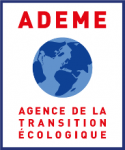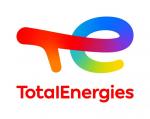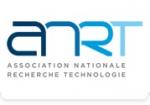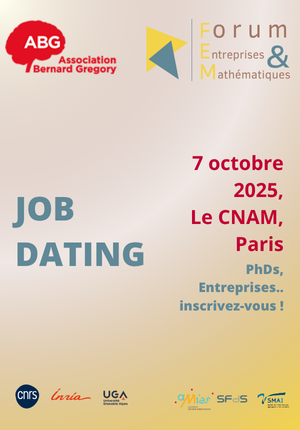Métallopeptides comme électrocatalyseurs pour la synthèse de carburants // Métallopeptides comme électrocatalyseurs pour la synthèse de carburants
| ABG-133255 | Thesis topic | |
| 2025-08-30 | Public/private mixed funding |
CEA Université Grenoble Alpes
Grenoble
Métallopeptides comme électrocatalyseurs pour la synthèse de carburants // Métallopeptides comme électrocatalyseurs pour la synthèse de carburants
- Chemistry
Chimie / Physique de l’état condensé, chimie et nanosciences
Topic description
L'hydrogène (H2) est un vecteur d'énergie propre prometteur, mais sa production industrielle repose principalement sur les énergies fossiles, conduisant à de fortes émissions de CO2. Seule une petite fraction est de l'"hydrogène vert", produit par électrolyse de l'eau avec des énergies renouvelables. De même, l'ammoniac (NH3), essentiel pour les engrais et l'industrie, représente un potentiel vecteur d'énergie non carbonée, mais sa production repose sur le procédé Haber-Bosch coûteux en énergie. La réduction électrochimique des ions nitrites (NO2-) en ions ammonium (NH4+) offre une alternative durable mais obtenir une haute efficacité et sélectivité de la réaction reste un défi. Des complexes métalliques présentant des ligands de type ATCUN (Amino-Terminal Copper and Nickel binding motif) se sont révélés prometteurs pour la production de H2 et NH3. Dans ce contexte, le projet ElectroPeps a pour but d'explorer le potentiel de complexes métalliques basés sur le motif ATCUN (M-ATCUN) comme électrocatamyseurs homogènes pour la production de H2 et NH3 en solution aqueuse et avec des performances optimales. Notre stratégie repose sur l'utilisation de ligands (pseudo-)peptidiques solubles dans l'eau, dont la séquence peut être aisément adaptée pour obtenir des séries de complexes métalliques bien définis. Des études de relations structure-activité, combinées à des études mécanistiques, nous permettront de rationaliser les paramètres clés pour une activité optimale de ces catalyseurs.
------------------------------------------------------------------------------------------------------------------------------------------------------------------------
------------------------------------------------------------------------------------------------------------------------------------------------------------------------
Hydrogen (H2) is a promising clean energy vector, but its industrial production is primarily based on fossil fuels, leading to high CO2 emissions. Only a small fraction is "green hydrogen," produced through water electrolysis using renewable energy. Similarly, ammonia (NH3), crucial for fertilizers and industrial applications, has potential as a carbon-free energy carrier but relies on the energy-intensive Haber-Bosch process. The electrochemical reduction of nitrite (NO2?) to ammonium (NH4?) offers a sustainable alternative but faces challenges in achieving high selectivity and efficiency. Metal complexes based on the ATCUN (Amino-Terminal Copper and Nickel binding) motif have shown potential for H2 and NH3 production. In this context, our project aims at investigate a series of ATCUN-based metal complexes (M-ATCUN) to design homogeneous electrocatalysts for H2 and NH3 production, active in aqueous solutions with optimal performance. Our strategy is based on the use of water-soluble peptide or pseudopeptide scaffolds that can be adequately modulated to isolate series of well-defined metal complexes. From a structure/activity relationship study combined with a mechanistic investigation, we attempt to rationalize the key parameters for optimal activity.
------------------------------------------------------------------------------------------------------------------------------------------------------------------------
------------------------------------------------------------------------------------------------------------------------------------------------------------------------
Pôle fr : Direction de la Recherche Fondamentale
Département : Institut de Recherche Interdisciplinaire de Grenoble
Service : DIESE
Date de début souhaitée : 01-11-2025
Ecole doctorale : Chimie et Sciences du Vivant (EDCSV)
Directeur de thèse : LALAOUI Noémie
Organisme : CNRS
Laboratoire : Département de Chimie Moléculaire (UMR 5250 UGA-CNRS)
URL : https://www.symmes.fr/Pages/Portrait/Sarah-Hostachy.aspx
URL : https://www.symmes.fr/en/Pages/CIBEST/Presentation.aspx
URL : https://dcm.univ-grenoble-alpes.fr/research/chimie-inorganique-redox
------------------------------------------------------------------------------------------------------------------------------------------------------------------------
------------------------------------------------------------------------------------------------------------------------------------------------------------------------
Hydrogen (H2) is a promising clean energy vector, but its industrial production is primarily based on fossil fuels, leading to high CO2 emissions. Only a small fraction is "green hydrogen," produced through water electrolysis using renewable energy. Similarly, ammonia (NH3), crucial for fertilizers and industrial applications, has potential as a carbon-free energy carrier but relies on the energy-intensive Haber-Bosch process. The electrochemical reduction of nitrite (NO2?) to ammonium (NH4?) offers a sustainable alternative but faces challenges in achieving high selectivity and efficiency. Metal complexes based on the ATCUN (Amino-Terminal Copper and Nickel binding) motif have shown potential for H2 and NH3 production. In this context, our project aims at investigate a series of ATCUN-based metal complexes (M-ATCUN) to design homogeneous electrocatalysts for H2 and NH3 production, active in aqueous solutions with optimal performance. Our strategy is based on the use of water-soluble peptide or pseudopeptide scaffolds that can be adequately modulated to isolate series of well-defined metal complexes. From a structure/activity relationship study combined with a mechanistic investigation, we attempt to rationalize the key parameters for optimal activity.
------------------------------------------------------------------------------------------------------------------------------------------------------------------------
------------------------------------------------------------------------------------------------------------------------------------------------------------------------
Pôle fr : Direction de la Recherche Fondamentale
Département : Institut de Recherche Interdisciplinaire de Grenoble
Service : DIESE
Date de début souhaitée : 01-11-2025
Ecole doctorale : Chimie et Sciences du Vivant (EDCSV)
Directeur de thèse : LALAOUI Noémie
Organisme : CNRS
Laboratoire : Département de Chimie Moléculaire (UMR 5250 UGA-CNRS)
URL : https://www.symmes.fr/Pages/Portrait/Sarah-Hostachy.aspx
URL : https://www.symmes.fr/en/Pages/CIBEST/Presentation.aspx
URL : https://dcm.univ-grenoble-alpes.fr/research/chimie-inorganique-redox
Funding category
Public/private mixed funding
Funding further details
Presentation of host institution and host laboratory
CEA Université Grenoble Alpes
Pôle fr : Direction de la Recherche Fondamentale
Département : Institut de Recherche Interdisciplinaire de Grenoble
Service : DIESE
Candidate's profile
Master
Apply
Close
Vous avez déjà un compte ?
Nouvel utilisateur ?
More information about ABG?
Get ABG’s monthly newsletters including news, job offers, grants & fellowships and a selection of relevant events…
Discover our members
 ASNR - Autorité de sûreté nucléaire et de radioprotection - Siège
ASNR - Autorité de sûreté nucléaire et de radioprotection - Siège  Généthon
Généthon  Nokia Bell Labs France
Nokia Bell Labs France  CESI
CESI  Institut Sup'biotech de Paris
Institut Sup'biotech de Paris  ADEME
ADEME  Tecknowmetrix
Tecknowmetrix  CASDEN
CASDEN  SUEZ
SUEZ  Ifremer
Ifremer  Groupe AFNOR - Association française de normalisation
Groupe AFNOR - Association française de normalisation  ONERA - The French Aerospace Lab
ONERA - The French Aerospace Lab  TotalEnergies
TotalEnergies  MabDesign
MabDesign  PhDOOC
PhDOOC  Aérocentre, Pôle d'excellence régional
Aérocentre, Pôle d'excellence régional  ANRT
ANRT  Laboratoire National de Métrologie et d'Essais - LNE
Laboratoire National de Métrologie et d'Essais - LNE  MabDesign
MabDesign

